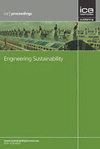Life cycle based considerations in design of driven piles in sand
IF 2.5
4区 工程技术
Q3 ENGINEERING, CIVIL
Proceedings of the Institution of Civil Engineers-Engineering Sustainability
Pub Date : 2024-04-20
DOI:10.1680/jensu.23.00099
引用次数: 0
Abstract
This study conducts a life cycle assessment to evaluate the environmental impacts of driven shafts across twelve different siliceous sand sites, selected from a database of static load pile tests. Through parametric studies, this paper investigates the influence of soil properties, pile geometry, and on-site activities on environmental impacts. For a single pile, findings demonstrate that material production is the most impactful phase, contributing 88.4% of global warming potential (GWP) per unit capacity, while on-site operations contribute minimally at 1%. Sensitivity analyses show that variations in fuel consumption by ± 25% and linear interpolations of blow counts result in negligible difference in GWP (less than 0.1% and 1%, respectively). On average, the total GWP for steel and concrete piles is approximately 4.3 and 0.92 kg CO2e per kN capacity, respectively. Although various factors influence pile design and installation, the results presented herein provide a foundational framework for geotechnical engineers to integrate environmental impacts into project planning, design, and construction considerations.基于生命周期的砂土打桩设计考虑因素
本研究进行了一项生命周期评估,以评价打入式竖井在 12 个不同的硅质砂地点对环境的影响,这些地点是从静载荷桩测试数据库中挑选出来的。通过参数研究,本文探讨了土壤特性、桩的几何形状和现场活动对环境影响的影响。对于单根桩而言,研究结果表明,材料生产是影响最大的阶段,占单位容量全球升温潜能值(GWP)的 88.4%,而现场作业影响最小,仅占 1%。敏感性分析表明,燃料消耗量 ± 25% 的变化和打击次数的线性插值导致的全球升温潜能值差异可以忽略不计(分别小于 0.1% 和 1%)。平均而言,钢桩和混凝土桩的总全球升温潜能值分别约为每千牛桩容量 4.3 千克二氧化碳当量和 0.92 千克二氧化碳当量。尽管影响桩基设计和安装的因素多种多样,但本文介绍的结果为岩土工程师将环境影响纳入项目规划、设计和施工考虑提供了一个基础框架。
本文章由计算机程序翻译,如有差异,请以英文原文为准。
求助全文
约1分钟内获得全文
求助全文
来源期刊

Proceedings of the Institution of Civil Engineers-Engineering Sustainability
ENGINEERING, CIVIL-ENGINEERING, CIVIL
CiteScore
3.70
自引率
16.70%
发文量
44
审稿时长
>12 weeks
期刊介绍:
Engineering Sustainability provides a forum for sharing the latest thinking from research and practice, and increasingly is presenting the ''how to'' of engineering a resilient future. The journal features refereed papers and shorter articles relating to the pursuit and implementation of sustainability principles through engineering planning, design and application. The tensions between and integration of social, economic and environmental considerations within such schemes are of particular relevance. Methodologies for assessing sustainability, policy issues, education and corporate responsibility will also be included. The aims will be met primarily by providing papers and briefing notes (including case histories and best practice guidance) of use to decision-makers, practitioners, researchers and students.
 求助内容:
求助内容: 应助结果提醒方式:
应助结果提醒方式:


